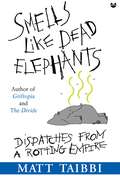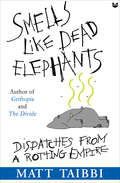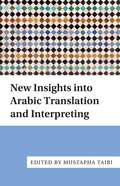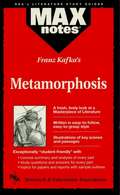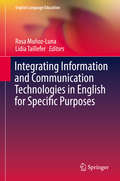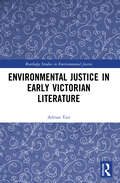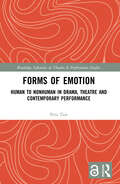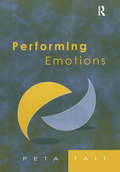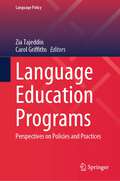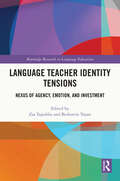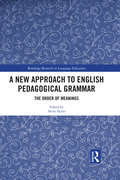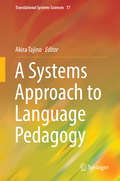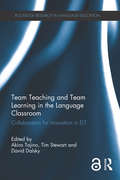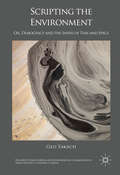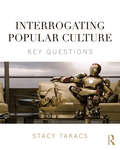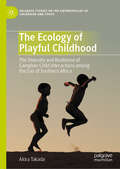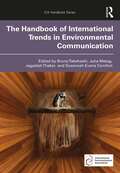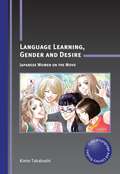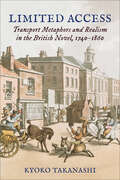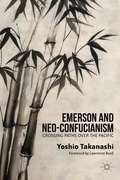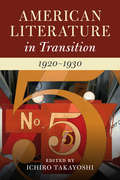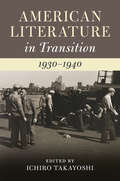- Table View
- List View
Smells like Dead Elephants: Dispatches from a Rotting Empire
by Matt TaibbiMatt Taibbi is notorious as a journalistic agitator, a stone thrower, a "natural provocateur" (Salon. com). His scathing, vibrant prose shines an unflinching spotlight on the corruption, dishonesty, and sheer laziness of our leaders. Smells Like Dead Elephants brings together Taibbi's most incisive, intense, and hilarious work from his "Road Work" column in Rolling Stone. Written over the last two years, a period in our history with no shortage of outrages to compel Taibbi's pen, these pieces paint a shocking portrait of our government at work--or, as Taibbi points out in "The Worst Congress Ever," rarely working. "In the Sixties and Seventies, Congress met an average of 162 days a year. The 109th Congress set the all-time record for fewest days worked by a U.S. Congress: 93. Figuring for half-days, in fact, the 109th Congress probably worked almost two months less than the notorious 'Do-Nothing' Congress of 1948". Taibbi has plenty to say about George W. Bush, Jack Abramoff, Tom DeLay, and all the rest, but he doesn't just hit inside the Beltway. He gets involved in the action, infiltrating Senator Conrad Burns's birthday party under disguise as a lobbyist for a fictional oil firm that wants to drill in the Grand Canyon. He floats into apocalyptic post-Katrina New Orleans in a dinghy with Sean Penn. He goes to Iraq as an embedded reporter, where he witnesses the mind-boggling dysfunction of our occupation and spends three nights in Abu Ghraib prison. And he reports from two of the most bizarre and telling trials in recent memory: California v. Michael Jackson and the evolution-vs.-intelligent-design trial in Harrisburg, Pennsylvania. A brilliant collection from one of the most entertaining political writers of today, Smells Like Dead Elephants is a stylish record of the offenses of the Bush years.
Smells Like Dead Elephants: Dispatches from a Rotting Empire
by Matt TaibbiSmells Like Dead Elephants is a brilliant collection from Matt Taibbi, a political reporter with the gonzo spirit that made Hunter S. Thompson and P. J. O’Rourke so much fun” (The Washington Post). Bringing together Taibbi’s most incisive and hilarious work from his Road Work” column in Rolling Stone, Smells Like Dead Elephants shines an unflinching spotlight on the corruption, dishonesty, and sheer laziness of our leaders. Taibbi has plenty to say about George W. Bush, Jack Abramoff, Tom DeLay, and all the rest, but he doesn’t just hit inside the Beltway. He gets involved in the action, infiltrating Senator Conrad Burns’s birthday party under disguise as a lobbyist for a fictional oil firm that wants to drill in the Grand Canyon. He floats into apocalyptic post-Katrina New Orleans in a dinghy with Sean Penn. He goes to Iraq as an embedded reporter, where he witnesses the mind-boggling dysfunction of our occupation and spends three nights in Abu Ghraib prison. And he reports from two of the most bizarre and telling trials in recent memory: California v. Michael Jackson and the evolution-vs.-intelligent-design trial in Harrisburg, Pennsylvania. Equally funny and shocking, this is excellent work from one of our most entertaining writers.
New Insights into Arabic Translation and Interpreting
by Mustapha TaibiThis book addresses translation and interpreting with Arabic either as a source or target language. It focuses on new fields of study and professional practice, such as community translation and interpreting, and offers fresh insights into the relationship between culture, translation and interpreting. Chapters discuss issues relating specifically to Arabic and the Arab cultural context and contribute views, research findings and applications that come from a language combination and a cultural background quite different from traditional Eurocentric theoretical and professional positions. This volume is a significant addition to resources on Arabic translation and interpreting and contributes fresh perspectives to translation studies in general. It is of interest to students, researchers and professionals working in public service, community, legal, administrative and healthcare translation and interpreting, as well as intercultural communication and translator education.
Metamorphosis (MAXNotes Literature Guides)
by Stanley TaikeffMAXnotes offer a fresh look at masterpieces of literature, presented in a lively and interesting fashion. Written by literary experts who currently teach the subject, MAXnotes will enhance your understanding and enjoyment of the work. MAXnotes are designed to stimulate independent thought about the literary work by raising various issues and thought-provoking ideas and questions. MAXnotes cover the essentials of what one should know about each work, including an overall summary, character lists, an explanation and discussion of the plot, the work's historical context, illustrations to convey the mood of the work, and a biography of the author. Each chapter is individually summarized and analyzed, and has study questions and answers.
Integrating Information and Communication Technologies in English for Specific Purposes (English Language Education #10)
by Lidia Taillefer Rosa Muñoz-LunaThis book fills the need for a text that integrates Information and Communication Technologies (ICTs) into English for Specific Purposes (ESP). It offers insights on current methodological principles in ESP in both academic and professional contexts, drawing on authentic teaching and learning situations, and analyses best practice guidelines. Part I begins with ESP pedagogical principles and technological practice in order to focus on its two main branches: English for Academic Purposes, which includes linguistic skills and students’ needs, and English for Occupational Purposes, specifically looking at Business, Medical and Translators courses. This book is a great resource for ESP researchers, educators and students, because it provides case studies of how ICTs can be used in English for multiple purposes. Authors present their experiences of integrating tools into their instructions, with each chapter contributing unique pedagogical implications.
Environmental Justice in Early Victorian Literature (Routledge Studies in Environmental Justice)
by Adrian TaitThis innovative new book combines environmental justice scholarship with a material ecocriticism to explore the way in which early Victorian literature (1837–1860) responded to the growing problem of environmental injustice. As this book emphasises, environmental injustice – simply, the convergence of poverty and pollution – was not an isolated phenomenon, but a structural form of inequality; a product of industrial modernity’s radical reformation of British society, it particularly affected the working classes. As each chapter reveals in detail, this form of environmental inequality (or ‘classism’) drew sharply critical reactions from figures as diverse as Thomas Carlyle, Friedrich Engels, Charles Dickens, and John Ruskin, and from within the Chartist movement, as working-class writers themselves reacted to the hazardous realities of a divided society. But as this book also reveals, these writers recognised that a truly just society respects the needs of the nonhuman and takes account of the material world in all its own aliveness; even if only tentatively, they reached for a more inclusive, emergent form of justice that might address the social and ecological impacts of industrial modernity, an idea which is no less relevant today. This book represents an indispensable resource for scholars and students working in the fields of Victorian literature, environmental justice, and ecocriticism.
Forms of Emotion: Human to Nonhuman in Drama, Theatre and Contemporary Performance (Routledge Advances in Theatre & Performance Studies)
by Peta TaitForms of Emotion analyses how drama, theatre and contemporary performance present emotion and its human and nonhuman diversity. This book explores the emotions, emotional feelings, mood, and affect, which make up a spectrum of ‘emotion’, to illuminate theatrical knowledge and practice and reflect the distinctions and debates in philosophy, neuroscience, psychology, and other disciplines. This study asserts that specific forms of emotion are intentionally unified in drama, theatre, and performance to convey meaning, counteract separation and subversively champion emotional freedom. The book progressively shows that the dramatic and theatrical representation of the nonhuman reveals how human dominance is offset by emotional connection with birds, animals, and the natural environment. This book will be of great interest to students and researchers interested in the emotions and affect in dramatic literature, theatre studies, performance studies, psychology, and philosophy as well as artists working with emotionally expressive performance.
Performing Emotions: Gender, Bodies, Spaces, in Chekhov's Drama and Stanislavski's Theatre
by Peta TaitIn Performing Emotions, Peta Tait's central argument is that performing emotions in realism is also performing gender identity. Emotions are phenomena that are performable by bodies, which have cultural identities. In turn, these create cultural spaces of emotions. This study integrates scholarship on realist drama, theatre and approaches to acting, with interdisciplinary theories of emotion, phenomenology and gender theory. With chapters devoted to masculinity and femininity specifically, as well as to emotions generally, it investigates social beliefs about emotions through Chekhov's four major plays in translation, and English language commentaries on Constantin Stanislavski's direction (of the play's first productions) and his approaches to acting, and Olga Knipper's acting of the central women characters. Emotions exists as social relationships; they are imagined and embodied as gendered. Tait demonstrates how theatrical emotions are predicated on social performances and vice versa. In Chekhov's plays, which came to dominate a twentieth century theatre of emotions, characters interpret their emotions intertextually in relation to other theatrical and fictional narratives of emotions. Tait here interrogates these plays as sustained explorations of the inherent theatricality of characters expressing emotions from their phenomenological awareness. A theatrical language of gendered interiority is produced in the acting of emotions in Stanislavski's early realistic theatre. Alternatively, remapping the performances of emotional bodies can destabilise the culturally constructed boundary separating an inner, private self and an outer, social self in culturally produced geographies of emotions. As Tait shows, emotions can be performed as indivisible spatialities. Performing Emotions integrates theories of theatre, gender identity and emotion to investigate how sexual difference impacts on the representations of emotions. The book develops an accumulative analysis of the meanings of emotions in twentieth century realist drama, theatre and acting.
Language Education Programs: Perspectives on Policies and Practices (Language Policy #34)
by Zia Tajeddin Carol GriffithsThis book delves into the realm of effective language education programs, examining them from both macro and micro-policy-making perspectives. It unravels the distinguishing features of exemplary language programs and explores how these programs are implemented in diverse international contexts. The book comprehensively explores various facets of language education programs, encompassing well-crafted language education policies, robust curriculum and syllabus design, impactful teaching materials, effective approaches to English for specific purposes (ESP), English as a medium of instruction (EMI), content and language integrated learning (CLIL), and English as a Lingua Franca (ELF)-informed instruction. The book also delves into fruitful school/institute-university partnerships, the judicious use of technology, strategies for teacher recruitment and professional development, as well as efficient policies for learner assessment, among other topics of significance. The contributions within this book are firmly grounded in data, incorporating findings from empirical studies. The insights provided draw upon valuable data obtained from a range of diverse contexts in which effective language education programs have been implemented.
Language Teacher Identity Tensions: Nexus of Agency, Emotion, and Investment (Routledge Research in Language Education)
by Zia Tajeddin Bedrettin YazanAddressing the critical issue of teacher identity tensions, this edited volume looks at the tensions between teachers’ instructional beliefs, values, and priorities, and the contextual constraints and requirements. It examines how teachers deal with these tensions to avoid demotivation and burnout, which play a significant role in identity construction. Tensions are inseparable from growth and transformation but have the potential to disrupt teacher identity construction. Therefore, continual efforts to resolve tensions in teaching are inevitable. The process of resolution or reconciliation might be extended, and teachers could need support in that process to minimize the possible negative impacts on their identities. This process can simultaneously generate positive outcomes for teachers’ growth and learning. Therefore, how teachers perceive, respond to, and grapple with tensions are critical experiences that offer windows into the complexities of teacher identity negotiation.The volume paints a picture of the personal, professional, and political dimensions of teacher identity tensions in various international contexts. The chapters draw on empirical studies with clear pedagogical implications to illustrate what identity tensions language teachers face in and outside the classroom during their career trajectory, how language teachers cope with identity tensions in their professional life, and how teacher educators can integrate identity tensions into teacher learning activities.This book is beneficial for students and lecturers in applied linguistics, educational linguistics, and educational psychology. It will also be helpful of interest to teacher educators, teacher education researchers, teacher supervisors, and MA and doctoral students interested in research on language teacher identity.
A New Approach to English Pedagogical Grammar: The Order of Meanings (Routledge Research in Language Education)
by Akira TajinoThis book proposes Meaning-order Approach to Pedagogical Grammar (MAP Grammar) as a practical pedagogical approach in ESL and EFL contexts. Teaching grammar through an easy-to-understand three-dimensional model, MAP Grammar establishes the clause as the fundamental unit of English and interprets meaning units in the sentence, thus allowing visualizable association between individual grammar items. By focusing on the order of meaning (rather than the order of words) in a sentence, MAP Grammar also distills current descriptive sentence structures (typically taught as five or seven patterns) into one meaning-based sentence structure for teaching and learning. MAP Grammar makes syllabus design and teaching easier in the following ways: Visualizing English grammar in a clear model, allowing association between individual grammar items. Instruction relies on meaning, not metalanguage, making MAP Grammar easy to grasp. The meaning-based sentence structure allows teachers to address global errors, and learners to produce comprehensible English.
A Systems Approach to Language Pedagogy (Translational Systems Sciences #17)
by Akira TajinoThis volume represents the first attempt in the field of language pedagogy to apply a systems approach to issues in English language education. In the literature of language education, or more specifically, second or foreign language learning and teaching, each topic or issue has often been dealt with independently, and been treated as an isolated item. Taking grammar instruction as an example, grammatical items are often taught in a sequential, step-by-step manner; there has been no “road map” in which the interrelations between the various items are demonstrated. This may be one factor that makes it more difficult for students to learn the language organically. The topics covered in this volume, including language acquisition, pedagogical grammar, and teacher collaboration, are viewed from a holistic perspective. In other words, language pedagogy is approached as a dynamic system of interrelations. In this way, “emergent properties” are expected to manifest. This book is recommended for anyone involved in language pedagogy, including researchers, teachers, and teacher trainers, as well as learners.
Team Teaching and Team Learning in the Language Classroom: Collaboration for innovation in ELT (Routledge Research in Language Education)
by Akira Tajino Tim Stewart David DalskyThis book reignites discussion on the importance of collaboration and innovation in language education. The pivotal difference highlighted in this volume is the concept of team learning through collaborative relationships such as team teaching. It explores ways in which team learning happens in ELT environments and what emerges from these explorations is a more robust concept of team learning in language education. Coupled with this deeper understanding, the value of participant research is emphasised by defining the notion of ‘team’ to include all participants in the educational experience. Authors in this volume position practice ahead of theory as they struggle to make sense of the complex phenomena of language teaching and learning. The focus of this book is on the nexus between ELT theory and practice as viewed through the lens of collaboration. The volume aims to add to the current knowledge base in order to bridge the theory-practice gap regarding collaboration for innovation in language classrooms.
Scripting the Environment: Oil, Democracy and the Sands of Time and Space (Palgrave Studies in Media and Environmental Communication)
by Geo TakachThis volume explores how to engage audiences both beyond and within the academy more deeply in environmental research through arts-based forms. It builds on a multi-pronged case study of scripts for documentary film, audio-visual and stage formats, focusing on how the identity of a place is constructed and contested in the face of environmental concerns around fossil-fuel extraction in a globalized, visual society--and specifically on the rising, international public-relations war over Alberta’s stewardship of the tar sands. Each script is followed by discussion of the author’s choices of initiating idea, research sources, format, voices, world of the story, structure and visual style, and other notes on the convergence of synthesis, analysis and (re)presentation in the script. Included are lively analysis and commentary on screenwriting and playwriting theory, the creation and dissemination of the scripts, and reflections to ground a proposed framework for writing eco-themed scripts for screen, audio-visual and stage formats.
Interrogating Popular Culture: Key Questions
by Stacy TakacsInterrogating Popular Culture: Key Questions offers an accessible introduction to the study of popular culture, both historical and contemporary. Beginning from the assumption that cultural systems are dynamic, contradictory, and hard to pin down, Stacy Takacs explores the field through a survey of important questions, addressing: Definitions: What is popular culture? How has it developed over time? What functions does it serve? Method: What is a proper object of study? How should we analyze and interpret popular texts and practices? Influence: How does popular culture relate to social power and control? Identity and disposition: How do we relate to popular culture? How does it move and connect us? Environment: How does popular culture shape the ways we think, feel and act in the world? Illustrated with a wide variety of case studies, covering everything from medieval spectacle to reality TV, sports fandom and Youtube, Interrogating Popular Culture gives students a theoretically rich analytical toolkit for understanding the complex relationship between popular culture, identity and society.
The Ecology of Playful Childhood: The Diversity and Resilience of Caregiver-Child Interactions among the San of Southern Africa (Palgrave Studies on the Anthropology of Childhood and Youth)
by Akira TakadaWhile studies of San children have attained the peculiar status of having delineated the prototype for hunter-gatherer childhood, relatively few serious ethnographic studies of San children have been conducted since an initial flurry of research in the 1960s and 1970s. Based on the author’s long-term field research among several San groups of Southern Africa, this book reconsiders hunter-gatherer childhood using “play” as a key concept. Playfulness pervades the intricate practices of caregiver-child interactions among the San: immediately after birth, mothers have extremely close contact with their babies. In addition to the mother’s attentions, other people around the babies actively facilitate gymnastic behavior to soothe them. These distinctive caregiving behaviors indicate a loving, indulgent attitude towards infants. This also holds true for several language genres of the San that are used in early vocal communication. Children gradually become involved in various playful activities in groups of children of multiple ages, which is the major locus of their attachment after weaning; these playful activities show important similarities to the household and subsistence activities carried out by adults. Rejuvenating studies of San children and hunter-gatherer childhood and childrearing practices, this book aims to examine these issues in detail, ultimately providing a new perspective for the understanding of human sociality.
The Handbook of International Trends in Environmental Communication (ICA Handbook Series)
by Bruno TakahashiThis handbook provides a comprehensive review of communication around rising global environmental challenges and public action to manage them now and into the future. Bringing together theoretical, methodological, and practical chapters, this book presents a unique opportunity for environmental communication scholars to critically reflect on the past, examine present trends, and start envisioning exciting new methodologies, theories, and areas of research. Chapters feature authors from a wide range of countries to critically review the genesis and evolution of environmental communication research and thus analyze current issues in the field from a truly international perspective, incorporating diverse epistemological perspectives, exciting new methodologies, and interdisciplinary theoretical frameworks. The handbook seeks to challenge existing dominant perspectives of environmental communication from and about populations in the Global South and disenfranchised populations in the Global North. The Handbook of International Trends in Environmental Communication is ideal for scholars and advanced students of communication, sustainability, strategic communication, media, environmental studies, and politics.
The Handbook of International Trends in Environmental Communication (ICA Handbook Series)
by Bruno TakahashiThis handbook provides a comprehensive review of communication around rising global environmental challenges and public action to manage them now and into the future. Bringing together theoretical, methodological, and practical chapters, this book presents a unique opportunity for environmental communication scholars to critically reflect on the past, examine present trends, and start envisioning exciting new methodologies, theories, and areas of research. Chapters feature authors from a wide range of countries to critically review the genesis and evolution of environmental communication research and thus analyze current issues in the field from a truly international perspective, incorporating diverse epistemological perspectives, exciting new methodologies, and interdisciplinary theoretical frameworks. The handbook seeks to challenge existing dominant perspectives of environmental communication from and about populations in the Global South and disenfranchised populations in the Global North.The Handbook of International Trends in Environmental Communication is ideal for scholars and advanced students of communication, sustainability, strategic communication, media, environmental studies, and politics.
Language Learning, Gender and Desire
by Kimie TakahashiFor many Japanese women, the English language has never been just another school subject. For them, English is the tool of identity transformation and the means of obtaining what they passionately desire - mobility, the West and its masculinity. Language Learning, Gender and Desire explores Japanese women's passion for learning English and how they negotiate identity and desire in the terrain of racial, sexual and linguistic politics. Drawing on ethnographic data and popular media texts, the book offers new insights into the multidirectionality of desire and power in the context of second language learning.
Violence in the Black Imagination: Essays and Documents
by Ronald T. TakakiIn "Violence in the Black Imagination", Ronald T. Takaki presents three short novels by major African-American leaders in the nineteenth century: "The Heroic Slave", by Frederick Douglass, the leading black abolitionist; "Blake", by Martin Delany, the father of black nationalism; and "Clotelle", by William Wells Brown, a pioneer of the black novel. The novels are accompanied by substantive essays which provide biographical information on the authors and explore the common theme of their works -- the issue of black revolutionary violence in antebellum America.
Limited Access: Transport Metaphors and Realism in the British Novel, 1740–1860
by Kyoko TakanashiA recurrent trope in eighteenth- and nineteenth-century British fiction compares reading to traveling and asserts that the pleasures of novel-reading are similar to the joys of a carriage journey. Kyoko Takanashi points to how these narratives also, however, draw attention to the limits of access often experienced in travel, and she demonstrates the ways in which the realist novel, too, is marked by issues of access both symbolic and material.Limited Access draws on media studies and the history of books and reading to bring to life a history of realism concerned with the inclusivity of readers. Examining works by Henry Fielding, Laurence Sterne, Walter Scott, Charles Dickens, William Makepeace Thackeray, and George Eliot, Takanashi shows how novelists employed metaphors of transport to constantly reassess what readers could and could not access. She gives serious attention to marginalized readers figured within the text, highlighting their importance and how writers were concerned about the "limited access" of readers to their novels. Discussions of transport allowed novelists to think about mediation, and, as this study shows, these concerns about access became part of the rise of the novel and the history of realism in a way that literary history has not yet recognized.
Emerson and Neo-Confucianism
by Yoshio TakanashiA comparative investigation of Emerson's Transcendental thought and Zhu Xi's Neo-Confucianism, this book shows how both thinkers traced the human morality to the same source in the ultimately moral nature of the universe and developed theories of the interrelation of universal law and the human mind.
American Literature in Transition: American Literature in Transition, 1920–1930
by Ichiro TakayoshiAmerican Literature in Transition, 1920-1930 examines the dynamic interactions between social and literary fields during the so-called Jazz Age. It situates the era's place in the incremental evolution of American literature throughout the twentieth century. Essays from preeminent critics and historians analyze many overlapping aspects of American letters in the 1920s and re-evaluate an astonishingly diverse group of authors. Expansive in scope and daring in its mixture of eclectic methods, this book extends the most exciting advances made in the last several decades in the fields of modernist studies, ethnic literatures, African-American literature, gender studies, transnational studies, and the history of the book. It examines how the world of literature intersected with other arts, such as cinema, jazz, and theater, and explores the print culture in transition, with a focus on new publishing houses, trends in advertising, readership, and obscenity laws.
American Literature in Transition, 1930–1940 (American Literature in Transition)
by Ichiro TakayoshiAmerican Literature in Transition, 1930–1940 gathers together in a single volume preeminent critics and historians to offer an authoritative, analytic, and theoretically advanced account of the Depression era's key literary events. Many topics of canonical importance, such as protest literature, Hollywood fiction, the culture industry, and populism, receive fresh treatment. The book also covers emerging areas of interest, such as radio drama, bestsellers, religious fiction, internationalism, and middlebrow domestic fiction. Traditionally, scholars have treated each one of these issues in isolation. This volume situates all the significant literary developments of the 1930s within a single and capacious vision that discloses their hidden structural relations - their contradictions, similarities, and reciprocities. This is an excellent resource for undergraduate, graduate students, and scholars interested in American literary culture of the 1930s.
American Writers and the Approach of World War II, 1935-1941
by Ichiro TakayoshiIchiro Takayoshi's book argues that World War II transformed American literary culture. From the mid-1930s to the American entry into World War II in 1941, preeminent figures from Ernest Hemingway to Reinhold Neibuhr responded to the turn of the public's interest from the economic depression at home to the menace of totalitarian systems abroad by producing novels, short stories, plays, poems, and cultural criticism in which they prophesied the coming of a second world war and explored how America could prepare for it. The variety of competing answers offered a rich legacy of idioms, symbols, and standard arguments that was destined to license America's promotion of its values and interests around the world for the rest of the twentieth century. Ambitious in scope and addressing an enormous range of writers, thinkers, and artists, this book is the first to establish the outlines of American culture during this pivotal period.
